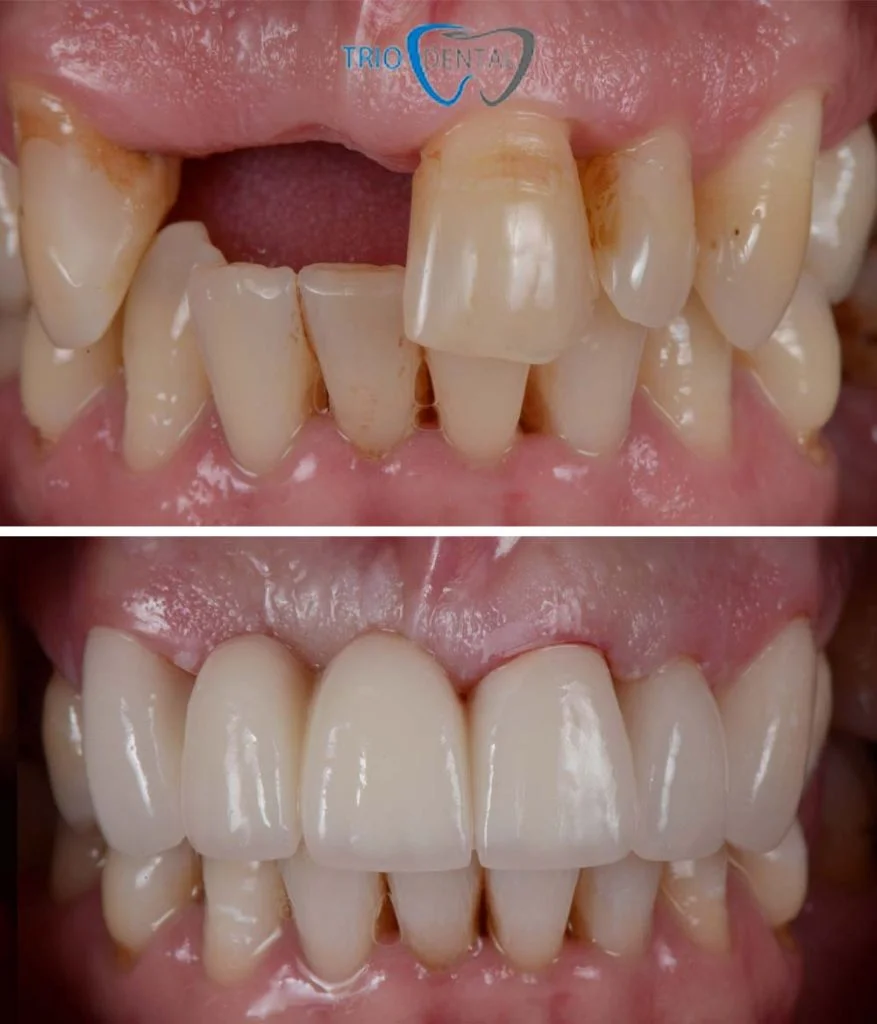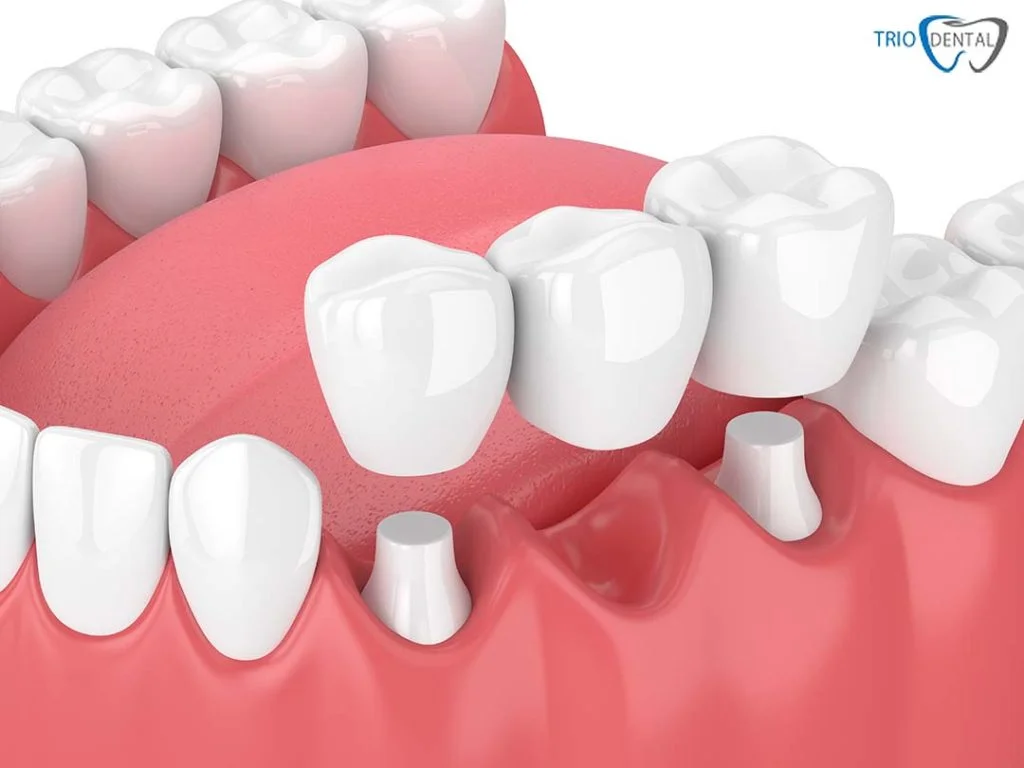at Trio Dental Center, Leading Dental Clinic for Dental Bridges in Albania




Are you having missing teeth, including your front teeth? Then a dental bridge in Albania can help you restore your mouth and teeth appearance as well as your teeth function. The most appropriate way in order to prevent any further tooth loss is to visit the dentists of Trio Dental Center.
Our staff can assist in choosing and exploring the best tooth replacement options, including dental bridges. We provide the most affordable dental bridges in Tirana; Albania and we help you avoid all the negative health effects that missing teeth create and appear.
If you want to be confident about your appearance and smile again in a comfortable way, then you should talk today with the dentists of Trio Dental Center and we will schedule an appointment for you in order to start the dental bridge placement procedure.
We’ve hand-picked an exclusive team of the country’s leading dentists.
Our team is here to help you identify which of our consultants is the right choice for you.

Ilda Meta
Orthodontist

Donato Sava

Marsida Murati

Kelta Brecai

Kristina Beqiraj

Jessica

Artjola
Customer Care

Mikaela

Tooth bridging is a very common method, which is used to replace one or more missing teeth. It is a form of fixed prosthetic work because it is permanently attached to the mouth resulting in the restoration of its function, maintaining the aesthetics of the smile and the face, unchanged.
The main feature of a bridge is that it rests on at least two adjacent natural teeth (braces), which must first be ground. It is firmly attached to them with adhesive mortar, while the gap is covered with an additional, artificial tooth.
The largest dental bridges are made depending on the number of teeth that have been removed and the teeth that will be used as supports. Finally, a dental bridge can be based on natural teeth or artificial ones, i.e., tooth implants, or a combination of both.
After the orthodontist has made the diagnosis and it has been decided, together with the patient, to resolve the lack of dental data with the dental bridge, the following steps will follow:

They are distinguished in:
Classic type: consists of one or more artificial teeth which are attached to two crowns that are placed on the teeth on either side of the missing ones (it is the most common method of placing a dental bridge)
Implant-supported: one or more dental implants are placed in order to replace the teeth-braces.
With cantilever: there are emergency solutions (e.g., when a rear molar is missing) and low-cost fillings, when there is no tooth available to support the bridge.
Maryland type: is the least invasive prosthetic restoration to replace a tooth, with minimal tooth removal. This type got its name from the University of Maryland where the relevant technique was discovered. In this case the tooth is held with special fins on the adjacent (adjacent) teeth
They are distinguished in:
Metal-ceramic: widely used. They are more expensive than metal-acrylic and cheaper than all-ceramic.
All-ceramic: their frame is made of porcelain and they do not have a metal core. They are new types of dental bridges, but their use is limited only to the anterior region of the mouth while they have a relatively reduced strength at a relatively high cost.
Zirconium (or zirconia): Their frame consists of zirconium oxide coated with porcelain. This material is very resistant to pressure, has a white color and allows light to pass through the porcelain, which is the most expensive choice.
Metal-acrylics: an economical choice but with low durability.
Metal bridges: they are rarely used anymore despite their great durability and low cost, they are unsightly. They are made entirely of metal (usually gold).
The dentist when examining your teeth will assess if a dental bridge needs to be placed in order to achieve a safe and permanent result. The placement of a bridge presupposes the existence of healthy teeth next to the gaps on which the dental bridge will be based.
The cases in which a dental bridge is placed include:

Are you having a missing tooth or teeth? Then this could affect you and your health in a number of different ways. A Dental Bridge can address those changes, when including:
The dentist will assess whether the dental bridge is the appropriate solution against the alternatives you have, first examining whether the existing teeth meet the appropriate conditions, in order to achieve its safe placement and to deal with any problems with other treatments. So, in this case:
However, the dental staff of Trio Dental Center is here to help you solve all your dental care problems and to give a solution to every problem that might be a retreat for the dental bridge placement.
At least 3 visits to the dental clinic are required in order to complete the process of construction and placement of a dental bridge:
On the First Appointment
All the damage of the teeth and the gums is repaired, such as the removal of the caries, the denervation (endodontic treatment), the placement of the filling, and so on. In case of loss of natural teeth for its support, the placement of implants must have preceded.
After local anesthesia, the teeth are ground (1 to 1.5 mm of dental tissue) in order to create the necessary space for the crown material in order to support the bridge. After that, a soft impression material is placed on the teeth in order to take the impression (‘measures’) according to which the dentist will build the bridge.
The teeth are covered by a temporary protective crown and then the patient, under the guidance of the dentist, decides on the material from which the bridge will be made.
The appropriate type of bridge for each case depends:
On the Second Appointment
The temporary rims are removed in order to test if the bridge fits properly on your mouth. The appropriate color is selected to perfectly match the color of your natural teeth and the temporary crowns are repositioned.
In case the patient chooses to do teeth whitening, this must be done strictly, before choosing a color because the bridge material does not whiten during the whitening process.
On the Third and Last Appointment
The bridge is placed in the patient’s mouth. In case the application is perfect, it is permanently glued to the teeth-supports with a special adhesive mortar.
Dental bridge placement has many aesthetic benefits, but also health benefits. Some of those benefits, include:
Dental bridges can be a good choice for replacing lost teeth. But before choosing this method, it is important to consult an orthodontist. He or she will help you resolve any questions you may have about materials, types, designs, and welding.
The patient’s approach to Dental Implants in Albania is personalized. The dentists of Trio Dental Center are well trained and have studied abroad as well as they have participated in numerous scientific conferences. Our staff deal with prosthetic restorations on a daily basis, choosing the dental bridges that fit perfectly in each case. Do not hesitate to call and to schedule your own appointment, and we assure you that the dental staff of Trio Dental Center will detect all your problems and fulfill all your needs and desires in a short period of time and with the most affordable prices.
A range of different materials, metal alloys, ceramics, porcelain, synthetic resin or a combination of these are used to make dental bridges. During the construction of the bridge, the material is often processed so that the final shade harmonizes with that of your natural teeth.
The durability of the implant bridge over time is ensured by good oral hygiene and regular check-ups by the dentist.
If you are looking for the best quotes with the best dentists in Tirana, Albania, but you don’t know if they will be able to attend your case; we have the perfect solution for you, you can write us your problem! This way our professionals will evaluate your case, give you a premise of what could happen once you arrive at our dental clinic in Albania, and could give you an approximate cost of what could be done with your case.
This service is totally free, we do not charge for giving you an estimate or advice. So we invite you to take the opportunity to listen to what the Dentist in Albania has to say about your illness or condition, they’ll probably have a totally different diagnosis than the one you’ve been given and it may also be fairly affordable compared to what they’re offering you in your country.
And even if you’re inside Albania but still are looking for a top Dentist in Tirana, we advise you to leave your case in the details box below so that we can give you a quote and schedule an appointment for you to come across a Dentist in Albania.